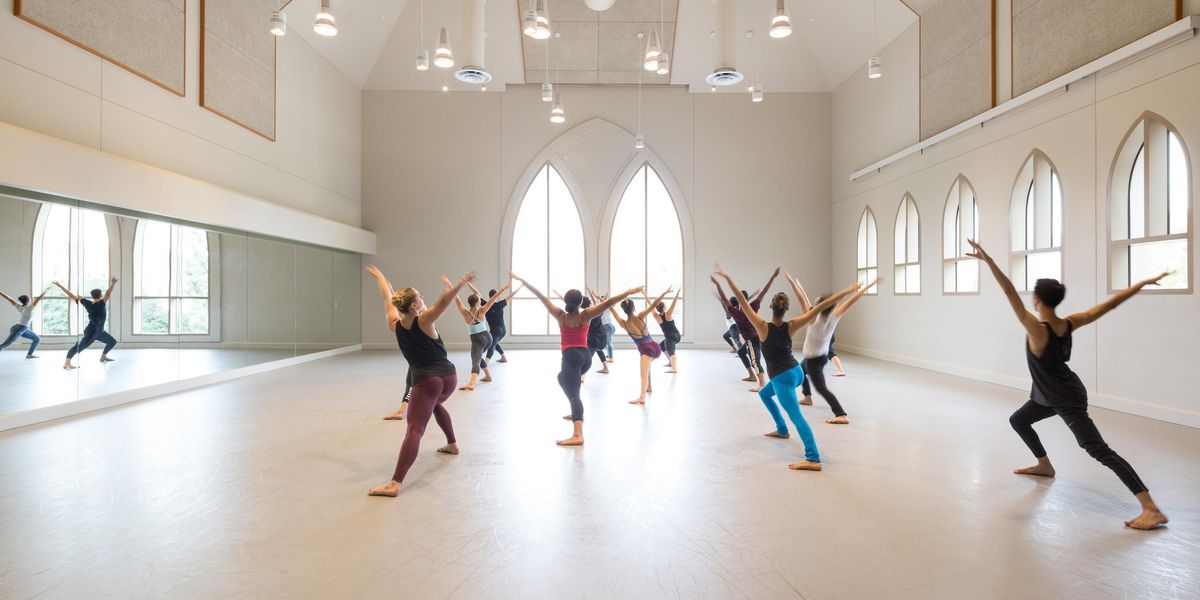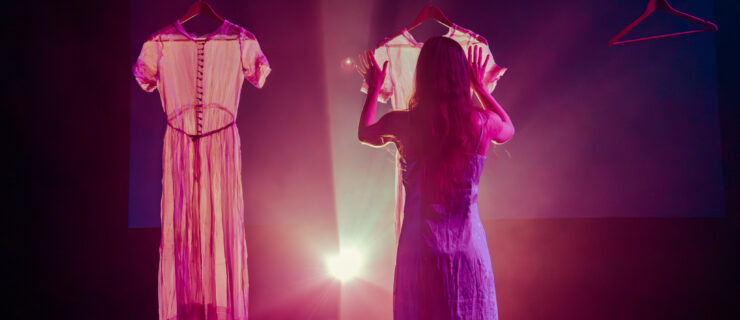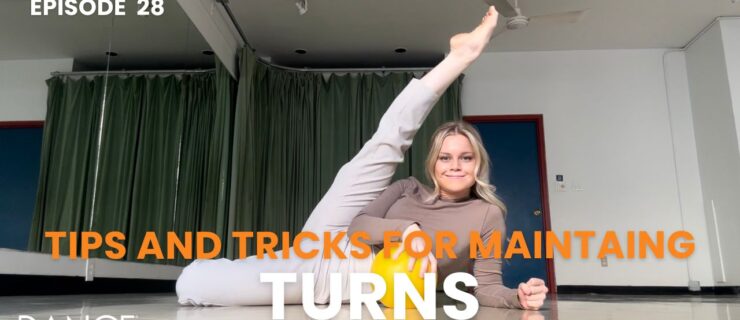Spirit Made Visible
Ronald K. Brown’s company, Evidence, celebrates 25 years.
As a little boy growing up in Brooklyn, Ronald Kevin Brown was in perpetual motion. His mom joked that it was hard to get him dressed for preschool because he was always dancing around and wouldn’t stand still. By second grade, having seen a performance of Alvin Ailey American Dance Theater, Brown was leading his cousins in making up dances in his family’s living room.
But for one reason or another, Brown never received serious dance training as a kid. He didn’t want to be the only boy in one class. At another point, his mother went into labor just when Ron was about to audition for a scholarship at Dance Theatre of Harlem. He took that as a sign that he should focus on being a good big brother. When he tried to apply to a performing arts junior high school, he was not accepted because he lived outside the district. “Something was always getting in the way,” Brown says.
These days nothing is getting in Brown’s way. He’s one of the hottest choreographers in contemporary dance. His kinetically exciting style—a fusion of African and Caribbean dance, hip hop and modern dance—has been embraced as much for its rich cultural context as for its overt spirituality. The company has performed all over the world, and Brown himself is in demand as a choreographer, teacher, and mentor.
At the American Dance Festival, where Brown has been a popular teacher as well as a performer, director Charles Reinhart says Brown has an uncanny connection with students. “He has such a strong, peaceful inner force. It comes out like the shepherd to the flock,” he says. “You just walk into the studio where he’s teaching, and before he starts you feel this aura coming from him. It’s so positive, so secure, that you already know it’s going to be a great class.”
This month Brown’s company, Evidence, A Dance Company, is celebrating its 25th year. The anniversary season at Harlem Stage looks back on Brown’s dances dating from 1996. For audiences, it’s a chance to experience a range of Brown’s work; for Brown, it’s an opportunity to gain perspective.
“All I have to do is look at the Ailey organization or talk to Donald McKayle, who had a company before I was born,” Brown said recently at his company’s home base, the Bedford Stuyvesant Restoration Corp. He also keeps in mind what Katherine Dunham, the iconic figure who pioneered the study of African and Caribbean dances, told him once at ADF: “Just don’t let us down.”
That’s “us” as in the black community.
Though he’ll turn 44 next month, Brown still has the trim, athletic look of a dancer. There’s no gray in the close-cropped beard or hesitation in his movements during rehearsals. Only recently has the choreographer begun taking himself out of his dances so he can focus on his dancers. But he still jumps back in if he has to.
“He’s trying to dance less, but he’s such an amazing dancer,” effuses Arcell Cabuag, who does double duty as a performer and the company’s associate artistic director. “His energy onstage is at 150 percent. He pushes you to take it to another level.”
Brown had decided, by high school, to become a storyteller via journalism. Performing was never far away, though. He got involved in theater and laughingly recalls that he was the guy doing cartwheels, splits, and other bits at the school talent show. But after graduating a year early from high school, he finally stepped into a dance studio. He’d taken a Graham class during the summer and was chagrined to discover he couldn’t get the hang of rounding his back in a contraction.
Suddenly journalism was put on the back burner. Brown turned his focus to dance, working nights and studying during the day with the renowned modern dancer Mary Anthony. As he began to develop his choreographic voice, those around him pushed him to consider using dance to tell the stories of his community. “I was hanging with a lot of writers and they were writing about our identity and legacy. One of them said, ‘Your work is in the dance,’ and I said, ‘Hmm.’ That gave birth to Evidence.”
Brown was 18 when the company gave its first concert in 1985 at the Mary Anthony Dance Studio. “It was with the idea that we must represent our families, our teachers, our ancestors, and that we must have a sense of responsibility.” When his first concert didn’t lead to instant bookings, he performed with Anthony’s company and Jennifer Muller/The Works and studied choreography with the legendary Bessie Schönberg.
“My first pieces were in street clothes, sometimes in sneakers. As I was learning different techniques, I was just moving and whatever came out came out,” he says. “Those early pieces were very physical. It was about how physical could I be while I told these stories?”
By the 1990s Brown had begun to explore a constantly expanding menu of movement from a range of cultures. His movement mélange draws from street dance, modern dance, capoeira, and other elements from the African diaspora. It’s a fusion that Brown says he arrives at naturally each time he begins to move.
His vocabulary is anchored in lightning-fast rhythmical footwork that mixes a samba-like step-ball-change with the high stepping of West African styles like manjani and linjin. And then there is the high-flying, darting move in which dancers hurtle through space, front leg bent, back leg stretched, arms flung back. Watching it, one feels the urge to move—as if the dancers’ energy has been sent out into the audience to jolt you out of your seat.
Dancer Tiffany Quinn says she learned quickly that the best way to pick up Brown’s “gumbo” approach was to stop trying to identify what he wanted the dancers to do. “The first time I took his class I thought, ‘This is crazy. What am I doing?’ I learned that at first, you have to just follow him,” says Quinn, who has been a company member since 2004. “Once you feel it in your body then you can break it down, pick it apart, and say, ‘Oh, OK. This is an arabesque turn into Afro-Cuban movement.’ When he’s creating, he goes into this zone and you just have to keep up with him. It’s really kind of cool.”
Cabuag recalls encountering Brown’s work at The Ailey School when he was a student there. “I wasn’t on the right floor for Ron’s workshop but I could hear the music. I asked my ballet teacher if I could use the restroom and went upstairs to that music and auditioned,” says Cabuag, who has been with Evidence since 1997. “There was a big sense of culture and spirituality. I felt drawn to it right away.”
While Brown has been lauded for his infectious, full-bodied fusion, his work has also been criticized by those who feel traditional dances should not be tampered with. But after a series of trips to the Ivory Coast beginning in 1995, the choreographer says, he began to see his work in a new light. There, he observed a range of styles and settings, from traditional dances at family gatherings to street dances at nightclubs. The dancers he met took fusion in stride. “They would say to me, ‘Why do you African Americans worry so much about what is authentic? When you touch it, it is something else. What we do in the village is different than what we do in the hotels for the tourists,’ ” Brown recalls. “I started to understand that as long as the integrity was intact, I could use different dance forms as resources. It was very freeing for me.”
Brown is the oldest of four children and has always taken his big brother role seriously. He would be the one to tell his siblings, “Make sure you come straight home from school.” Since his mother died 14 years ago, he has gotten even more involved. His nephew Ame Bender partly inspired Brown’s Two-Year-Old Gentlemen (2008). (According to an interview in Time Out New York, when Uncle Ron asked the then 3-year-old to be in the piece, the child replied, “Let me think about it.”) A celebration of brotherhood, Two-Year-Old Gentlemen will be graced with a cameo appearance by Ame, now 5, when it is performed at Harlem Stage (see sidebar).
His sense of responsibility has stretched to include faraway dance communities that he feels a kinship with. On the recent State Department–sponsored tour of Senegal, South Africa, and Nigeria, (see “Dance Matters,” January), Brown encouraged other artists to teach and respect their art form. “We have to support each other and then all the rest will come.”
Spirituality has remained a constant theme in Brown’s work—whether the choreographer is blessing his studio with sage, talking about how the ancestors speak to him, or using gospel music. Some of his works have overtly religious themes, like Grace, the tour de force he created for the Ailey company in 1999.
In Grace, a priestess figure leads a group of congregants upstage towards a shaft of light, suggesting deliverance to a state of grace.
Brown says he knows such overt spirituality is not in vogue in the contemporary dance world. But for him, there is no separation between the body and spirit, dance and prayer. “Spirituality is always with us and it’s always a part of my work,” he says. “For me, love and God are the same. If you feel love and are lifted up from my work, that’s great. That’s what it’s all about.”
E-Moves celebrates 25 years of Ronald K. Brown & Evidence
June 17–19, at Harlem Stage Gatehouse
Program 1: For You, Better Days, Incidents, and To Harm the Dangerous
Program 2: Two-Year-Old Gentleman and One Shot
In honor of Father’s Day, Ron Brown will conduct a workshop for boys and their elders on June 19. See www.harlemstage.org.
Watch video of Evidence at dancemagazine.com.
Karyn D. Collins is a freelance writer based in NJ.
Pictured: Juel Lane, Ronald K. Brown, and Arcell Cabuag in Brown’s
Grace. Photo by Basil Childers, Courtesy Evidence




